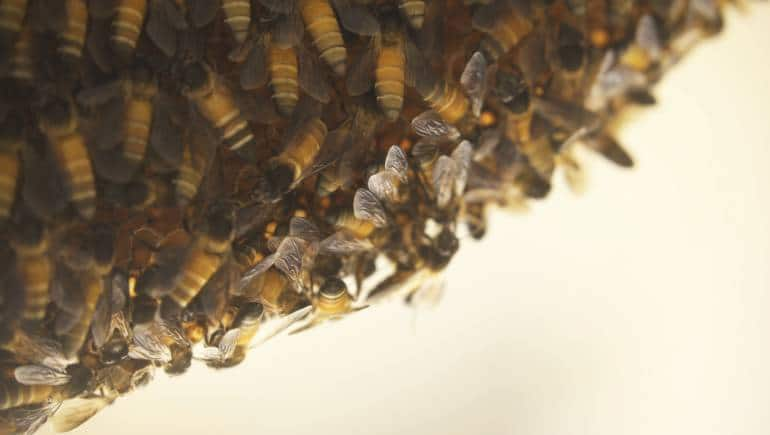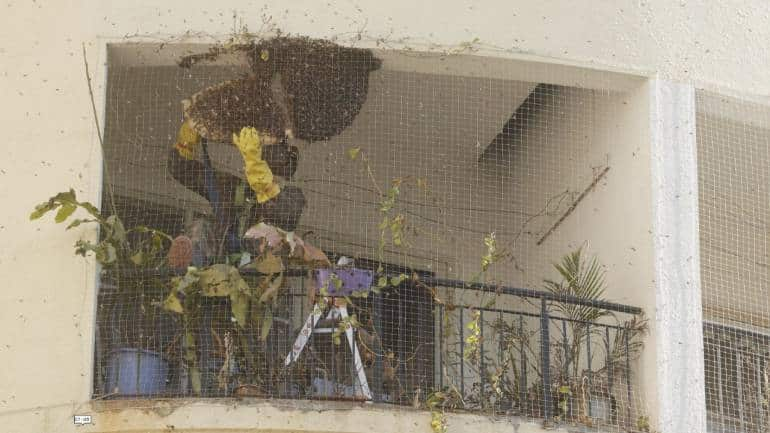



That proverbial pot of gold at the end of the rainbow could very well be the massive beehive on the ledge of your apartment building. Sadly, you probably don’t know it yet. Which is why Bangalore-based filmmaker Rajani Mani is looking forward to the screening of her documentary Colonies in Conflict in the city to create awareness and sensitivity towards bees.
The film navigates the rock bees’ (Apis dorsata) territories as they try to survive in the urban landscapes. Rock bees are among the three native varieties found across India. Even as the population of these robust pollinators is declining, scientists are hoping that sooner rather than later, the immense value of bees will be appreciated by the urbanites.

Globally, the economic value of bees is estimated to be at least tens of billions of dollars. According to a 2017 paper (on ResearchGate), the estimated economic value of bee-pollinated crops is about USD 4 billion.
But how does the big picture help us in looking at the beehive hanging menacingly on a ledge near us?
“There is a lot of hearsay about these bees – that they are killer bees, they are dangerous, their sting is fatal and so on,” Mani said in an email interview. “But almost every assumption is from hearsay, I would not say that these bees are misunderstood, but that they are not understood at all. So, when I started researching about A. dorsata, I found a story that I wanted to share with everybody. While the story is about a particular species of an insect, it is true for insects everywhere.”
Incidentally, the direct contribution of insect pollination to Indian agriculture is at 22 billion dollars*.
Dr Axel Brockmann, a senior scientist at Bengaluru’s National Centre for Biological Sciences – Tata Institute of Fundamental Research, who was one of the advisers to the documentary, said, “Unfortunately, in India, the decline of insect pollinators is not a public concern, as yet. Even many wildlife activists are only concerned about the ‘big animals’.”
 Rock bees are migratory.
Rock bees are migratory.
So, what do we know about honey bees in India? According to Dr Brockmann, India is among the countries with the highest diversity of honey bee species. Of the five honey bee species native to India, two of them occur in the Himalayas and the other three, A. florea, A. dorcata and A.cerana are found in the rest of the country.
Giant honey bees often nest in aggregations. The so-called ‘bee trees’ can host more than 50 colonies. But things are changing. Dr Brockmann said, “A huge banyan located amidst fields on the grounds of the University of Agricultural Sciences in Bengaluru, used to be such a bee tree. In 2002, about 100 Apis dorsata colonies lived in this tree. It was described as: ‘They looked like big fruits. At sunset, first birds in the tree started flying – the colourful bee eaters. Then many thousands of bees from all the colonies started to fly and the tree released a humming sound that could be heard from far away. Really a magical spectacle of nature.’ Fifteen years later, only two colonies remained. Eucalyptus and other trees nearby, which provided a lot of nectar, were cut and the honey bees are gone.”
 Dr Axel Brockmann
Dr Axel Brockmann
Interestingly a survey found that in southern Karnataka, most of the colonies were not on farmland or natural habitats but in residential areas. Cities, like Bengaluru, New Delhi, Pune, Mumbai and so on, are not necessarily bad for the bees. Rock bees are a migratory species and visit a particular area during what scientists call the ‘nectar flow’ season.
“The flowering trees that Bangalore has in plentiful, trees like eucalyptus, copper pod, tabebuia, jacaranda, and pongamia offer a feast to wild bees when in full bloom,” Mani said. “We see a spike in rock bees colonies during this time. These bees build very large hives with 30-40,000 individuals in one beehive. Since they are open nesting bees, they require large rocks to build hives on or large trees with wide crowns. The expanding city required the trees to be cut and rock faces to be replaced by a concrete jungle. The bees, however, found the apartments to be just as steady as rocks and adapted to set up their hives on apartments instead!”
All Indian cities growing vertically will have colonies of rock bees because, as Dr Brockmann remarked, these giant honey bees seem to be pre-adapted to this kind of city. “Unconsciously, humans build artificial nest sites of giant honey bees.” Yet, between 1987 and 2014, the number of colonies in Bengaluru alone was reduced by 90 percent. Felling of trees, air pollution – the bees are affected by poor air quality – and the intentional killing of the colonies are the top three reasons.
That brings the focus back on how urbanites should look at the bees. Dr Brockmann talks of the ‘mass flights’ phenomenon which is decidedly a scary sight. During early morning, there is a rearing as they all swarm around. Something happens for five to ten minutes, and at that time, it’s a little scary. And in the evening, they could do the same.
Apart from such behaviour, the rock bees are sensitive to light in the night. “Being phototactic they are attracted to light and foragers get drawn into homes at night and that is frightening to people,” said Mani about the rock bee workers which are able to fly and forage at low-light intensities.
 Rajani Mani
Rajani Mani
Occasionally, there have been attacks on humans because the rock bees have reacted to disturbances. “At least 150 to 1,000 honey-bee stings are necessary to kill somebody who is not allergic to the bee venom and so mass attacks can be very dangerous,” Dr Brockmann said. “Big honey bee colonies have tens of thousands of workers and if one Apis dorsata colony starts a mass attack, the neighbouring colonies will join in.”
In 2017, a seven-year-old girl died of an attack when playing close to a colony in Lal Bagh Botanical Gardens in Bengaluru. A few people were injured in separate incidents and as a consequence, all the colonies were removed from Lal Bagh. “Giant honey bees are treated like a pest insect in most cities India. It is allowed to call a pest management company to remove a honey bee colony nesting under the roof of your house or on your balcony.”
While both Mani and Brockmann lament about the unnecessary conflict -they stress the importance of co-existing peacefully. If you have ever bought honey from those who smoke out the bees from your apartment building, then it is time to give the bees some space. Let them stay and sweeten your time on earth.
Colonies in Conflict will be screened on May 22 at the Bangalore International Centre from 5pm to 8pm.
 A hive of giant honeybees
A hive of giant honeybees
Experts’ notes on Rock bees
Rock bees are a migratory species; they come between October and March, when the flowers are in bloom. In the Western Ghats, the rock bees stay from February to May. In South India, coffee blooms between September and December - rock bees are major pollinators of coffee.
They are responsible for a significant percentage of the pollination of wild flora and cultivars, and they benefit several landscapes on their migratory journeys between our apartment perches and fields and forests.
Rock bee was a close contender to become Karnataka’s first state insect by Karnataka Biodiversity Board. It was pipped to the post by A. Cerana aka Asian honey bee.
What to do when you see a beehive?
When you see beehives in your society, remember they are your guests for a short period. The best option is to close the windows and doors closest to the hive. Draw the curtains at night.
If you cannot live with the hive, then call a humane bee remover. Smoking the colony and only removing the comb – which will make the bees move away – is better than killing them all with pesticides. Even the transfer of a colony together with its nest is possible. However, Apis dorsata colonies have preferred nesting sites. Residents who have removed colonies from their balconies should take measures to prevent new colonies from building nests on their balconies.
Discover the latest Business News, Sensex, and Nifty updates. Obtain Personal Finance insights, tax queries, and expert opinions on Moneycontrol or download the Moneycontrol App to stay updated!
Find the best of Al News in one place, specially curated for you every weekend.
Stay on top of the latest tech trends and biggest startup news.